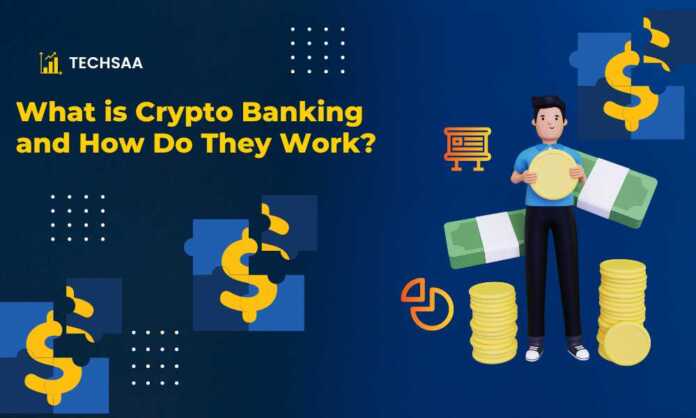Digital technology is facilitating an era of rapid innovation in the banking business. This innovation is spearheaded by crypto banking. In this post, we present an overview of crypto banking and describe the fundamentals of its functioning.
What Exactly is Crypto Banking?
Crypto banking is the administration of digital currency by a bank or other financial entity. In contrast to conventional banks, which hold fiat currency and conventional financial assets solely, crypto banks also hold cryptocurrency. The function of crypto banks is to enable exchange and interaction between fiat currency and cryptocurrency. Checking accounts, custodian banking, cross-border payments, and yield management may be offered as part of crypto banking services. Some cryptocurrency banks provide cryptocurrency interest accounts. These operate similarly to typical bank accounts: banks borrow the funds in savings accounts to lend to third parties, in exchange for which they pay consumers interest.
What Role Does Cryptocurrency Play in National Banking Systems?

The banking system is backed by a hierarchy of money, with the central bank’s reserves at the top, followed by the deposits of the major national banks. This is followed by deposits from banking resources that do not have direct access to central bank reserves (such as eurodollars in the US Fed system).
Cryptocurrency is comparable to foreign banking reserves; however, instead of a national currency sitting in a foreign account, it is a currency that resides on a blockchain. For instance, a virtual currency like USDC is backed 1:1 with the US dollar, yet the coin falls outside of US bank regulation.
As a result, a new monetary hierarchy is being established within banking systems due to cryptocurrency. The currency produced by the central bank is the purest form but is also the most centrally managed. The degree of control diminishes through commercial deposit accounts and foreign bank deposits until cryptocurrencies are reached. At the bottom of the scale, cryptocurrencies are the most permission less type of currency that banks support.
How Do Cryptocurrency Banks Generate Revenue?
Historically, banks have gained money from net interest revenues, the difference between the percentage of interest they charge to lend money and the percentage of interest they pay to keep borrowing from their customers.
The typical risk associated with this approach is either 1) the borrower’s inability to repay a loan or 2) fluctuations in interest rates rendering existing burdens unprofitable. There are two extra dangers in crypto banking: 1) when a loan is over-collateralized, and the bank must sell the collateral to cover losses, and 2) when the blockchain code is exploited, resulting in financial losses. Entire reserve banks reduce these risks by keeping at all times 100 percent reserves in fiat currency. Others build a buffer between assets and liabilities on the balance sheet using fractional reserve methods.
What Prevents Crypto Banks from Lending Too Much?
There are two primary criteria that inhibit crypto banking activities and, in turn, decrease risk. The first consideration is a bank’s capacity to satisfy its financial obligations or its solvency. Solvency is ensuring banks do not lend more than they can repay and do not make poor investments.
As previously stated, complete reserve banking mitigates these difficulties by guaranteeing that no risks are made with bank deposits. The majority of stablecoins backed by fiat, including those supplied by BVNK, fall into this category. Basel III requires fractional-reserve banks to maintain a sufficient excess, and these banks generally comply with this requirement.
Liquidity is the second significant limitation. The issue for banks is to avoid tying up all of their higher-value assets, as doing so could put them in danger if all customers opted to withdraw their funds simultaneously — even if the bank was theoretically healthy. Again, Basel III is significant because it establishes the overall amount of higher-level money that banks must maintain. Some banks incentivize crypto investors to lock up their funds for a number of years in order to maintain an adequate liquidity pool.
What is the Future of Crypto Banking?
The banking and cryptocurrency sectors continue intertwining, and crypto banks are maturing quickly. The rise of crypto banking and payment platforms like BVNK, which allow corporations to combine their fiat and cryptocurrency banking on a single platform, is a particularly dynamic development area. Such platforms will assist businesses in meeting the growing demand from clients for dependable crypto payment choices while also facilitating the more efficient and cost-effective transfer of funds internationally.
Check out: How Autodialers Use Machine Learning to Optimize Sales Campaigns

